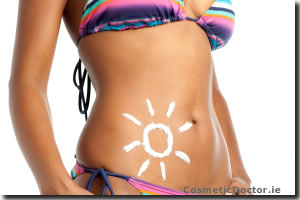The Sun. Friend or Foe?
Is it possible to enjoy the sun safely? Have you ever wondered what sunscreen does? How much to apply? And how often?
Here is a simplified step by step guide to answer all your questions.
Sunscreen is a lotion, spray, gel or cream which absorbs or reflects some of the sun’s ultraviolet (UV) radiation on the skin exposed to sunlight and thus helps protect against sunburn, wrinkles and skin cancer. We all want beautiful glowing, smooth, soft skin without sun spots or uneven pigmentation.
Well in order to maintain even toned, pigment free skin you need to slap on your sunscreen daily.
How does the sun affect your skin?
UVA is the major contributor for ageing, wrinkling and loss of elasticity. Think “A for Ageing” . Remember than UVA can even penetrate glass so you may even be affected when driving your car. This explains why people living in Ireland tend to have more sun damage on the right side of their faces whilst in Europe and the US the ravages of the sun are most noticeable on the left side of one’s face. Being indoors all day does not mean that you are safe either, especially if you are sitting close to a window. Have you ever wondered why carpet close to a window fades more than carpet in the rest of the room?
UVB is the primary agent responsible for sunburn, tanning and skin cancer. It has been shown that UVB rays cause a much greater risk of skin cancer than UVA.
There are many different sunscreens, which one should I use?
Sunscreens can contain either chemical or physical blockers. Chemical blockers contain a combination of ingredients to provide protection against both UVB and UVA radiation.
Physical blocks place a coating on the skin that reflects light energy. Physical blocks are also effective at protecting against both UVA and UVB radiation. The two most common physical blockers are titanium dioxide and zinc oxide. These are the ingredients which can give sunscreens their white colour. Newer formulations contain micronised zinc oxide which do not leave a white film on the skin and are more user friendly.
What does SPF mean?
SPF indicates the ability of a sunscreen to block the UVB spectrum.
Put simply, a sunscreen with an SPF of 10 will delay the onset of a sunburn in a person who would otherwise burn in 10 minutes to burn in 100 minutes. The SPF 10 sunscreen allows a person to stay out in the sun 10 times longer.
Is SPF 50 better than SPF 30?
It has been shown that there is limited benefit using a sunscreen greater than 30. However if you are in direct sunlight it is important to reapply sunscreen every two hours.
How much sunscreen should you apply?
Many of us do not know how much sunscreen to apply, as there are no instructions or directions with sunscreen products. It s advisable to use more than half a teaspoon on your head and neck and per arm with each application. Use more than a teaspoon on the chest, back and both legs per application. Apply sunscreen every two hours and ideally it should be applied 30 minutes before going out in the sun.
“Waterproof” sunscreen should provide protection in the water for 80 minutes, while “water resistant” provides only 40 minutes of protection. So if you are in and out of the water APPLY and REAPPLY.
Tip 1 : So if you do not want lines and wrinkles or worse still skin cancer, do not forget to slap on your sunscreen daily. Wear your sunscreen in all weather conditions not just on a sunny day.
Tip2: If you have children do not forget to make sure that they wear sunscreen on a daily basis.
Tip 3: Guidance from the FDA states that there is no sunscreen which can state that ” it lasts all day”. It is important to reapply if you are in direct sunlight or on the slopes.
Associated treatments
Heliocare
Pigmentation treatments
Obagi Nu-Derm cosmeceuticals
IPL treatments

